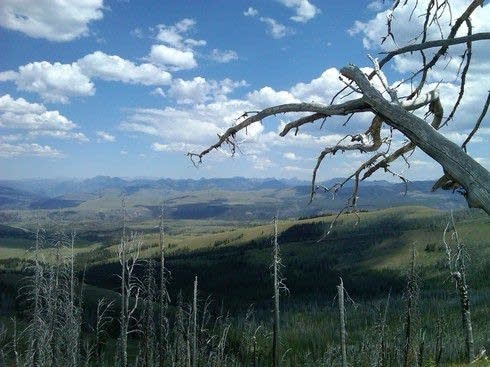Forests on fire: Climate change triple whammy

Want to see climate change in action?
Take a drive to the Black Hills of South Dakota or just about any forested slope in the Rocky Mountains.
“We are at the point in the Black Hills where whole hillsides are dying and that is not the effect we want. The scale of dead stands has grown to be too big.” -Kurt Allen, Forest Service entomologist at Rapid City

Forests and climate change
Create a More Connected Minnesota
MPR News is your trusted resource for the news you need. With your support, MPR News brings accessible, courageous journalism and authentic conversation to everyone - free of paywalls and barriers. Your gift makes a difference.
Human emissions of CO2 and other greenhouse gasses into our atmosphere is often the main focus of climate science. But an important new element of carbon transfer into the atmosphere is emerging as climate shifts. The increasing role of forest fire activity in changing the carbon balance is getting more attention. As millions of additional acres of forests go up in smoke in places like California and the American West, scientists are learning it's triggering a triple whammy effect on climate.

Black Hills: A climate change laboratory?
Anyone who has been to the Black Hills in the past few years has noticed dramatic changes in forests compared to just 20 years ago. I wrote about my visit to the Black Hills and Yellowstone National Park in 2012. It was my first visit since 1994. I was shocked at the magnitude of the dramatic landscape changes in just 18 years. Today's Black Hills are not your father's Black Hills.
The climate of the Black Hills has changed significantly in the past 20 years. But even subtle shifts in climate in marginal climate zones like the Black Hills can cause dramatic landscape changes.
The previous climate of the Black Hills provided just enough moisture for beautiful black spruce forests to thrive. Temperatures got cold enough in winter to keep pests at bay, like the mountain pine bark beetle.
The the climate began to shift, and a vicious cycle of landscape change kicked in. It goes something like this.
Climate changes favor warmer and drier conditions, winter extreme temperatures rise
Pest mortality due to extreme cold drops dramatically
Pests like the pine beetle thrive, attack and weaken entire mountainsides of trees
The drier hotter climate further weakens trees
Forest stands die off
Fire sweeps through the now dead and dry timber and changes the landscape
As officials try and treat diseased trees, the resulting climate change driven landscape looks like this.

California forests on fire
The term "fire season" in California has become a bad running joke. Fires now burn in just about every month of the year in California.

As climate shifts the increase in large fires in the American West over the past few decades has been dramatic.

As much as 6 percent of massive California has been burned by wildfire in the past few decades. Climate Central has more on a new study that finds massive forest fires are injecting even more carbon into the atmosphere.

A Californian task force has been handed the confounding task of figuring out how forestry and land management practices could be improved to prevent what scientists say are surprisingly high levels of climate pollution escaping from its forests and other wildlands.
A new study has shown that greenhouse gases are billowing out of the state’s forests faster than they are being sucked back in, with unnaturally intense wildfires mostly to blame.
“Ecosystems are regrowing, but not fast enough,” Patrick Gonzalez, a U.S. National Park Service climate change scientist involved with the research, said. “The losses are outpacing the growth. The key element here is wildfire.”
From 2001 through 2010, the state’s wildlands were responsible for about 8 million tons of carbon pollution annually — more climate pollution than is released every year by the entire economy of Vermont.
That was the conclusion of a sophisticated analysis requested and partly funded by California’s air resources board. Wildfires affecting a small portion of the state were responsible for two-thirds of the estimated losses of carbon from what had been living plants.
Under more stable natural conditions, the state’s forests would be expected to absorb about as much carbon as they lost every decade. At a time of unnaturally high carbon dioxide levels, the forests would ideally absorb more of the greenhouse gas than they produce. But the balancing act has been thrown off kilter.
Forest fires: Climate change triple whammy
Climate scientists are learning the increase in large forest fires and the additional injection of carbon into the atmosphere is triggering a climate change triple whammy.
Here's a simplified version of how this turbo charged climate change cycle works.
Forests burn and release stored carbon into the atmosphere, further increasing atmospheric carbon.
The charred landscape after the fires is less efficient at removing carbon from the atmosphere.
Black soot from the massive fires is carried by winds thousand of miles into the Arctic where it lands on previously white (reflective) snow and ice. The now Dark Snow and ice absorbs sunlight much more efficiently, causing accelerated melting in the Arctic regions.
Sometimes it's not easy to see climate changes in our backyards in the short term. But if you look over time frames of even a few years and across wider geographic regions you begin to see just how dramatically the bigger picture of climate change is unfolding.